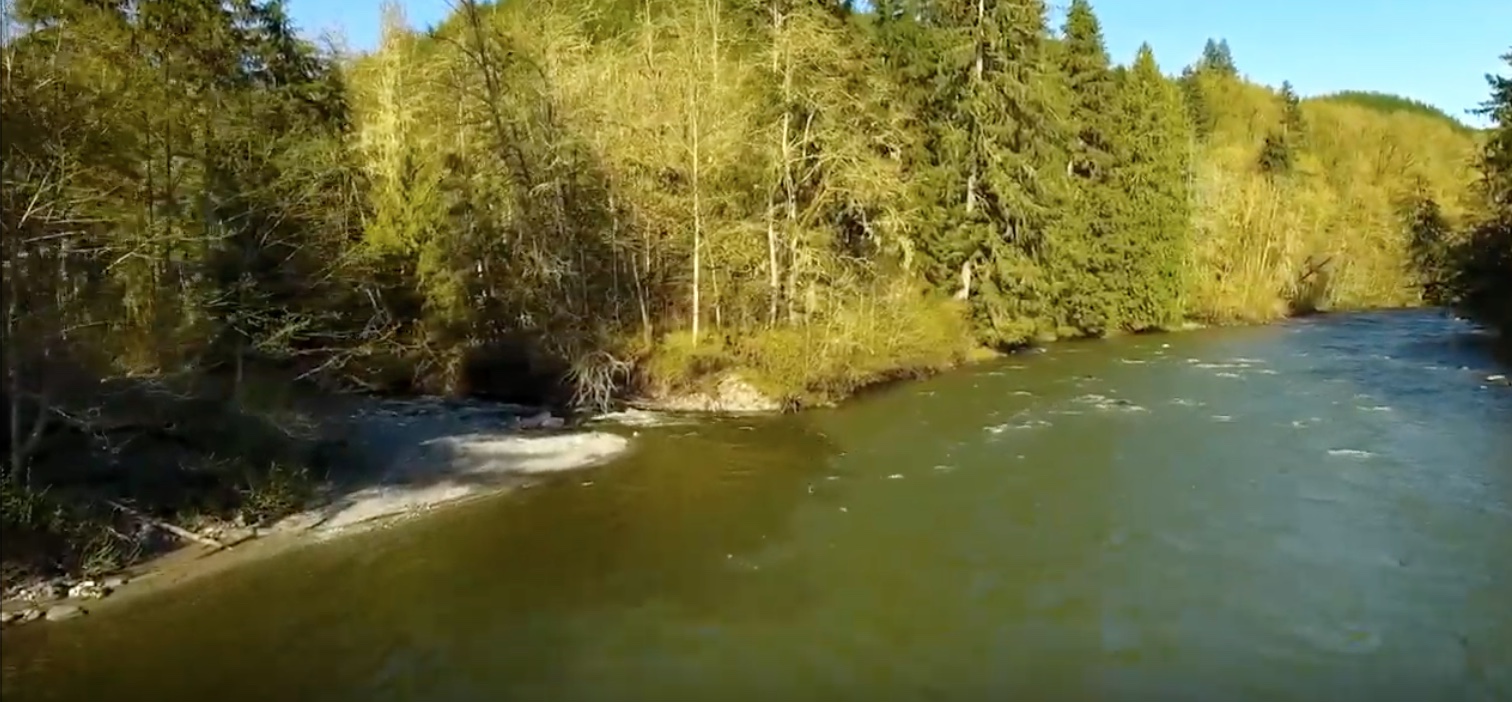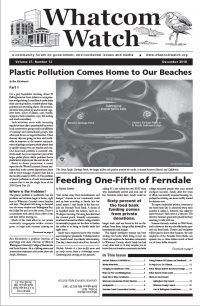by Whatcom Land Trust Staff
The waters of Skookum Creek are so clear that at times they appear translucent. The major tributary of the lower South Fork of the Nooksack River has a 22-square-mile watershed made up of wooded areas relatively untouched by humans. For millennia it has flowed with abundance, benefiting native peoples whose culture was shaped by its reliable bounty. More recently, a good portion of the land along its path has been used for commercial timber harvest. Yet Skookum Creek’s story is much more than picturesque.
The Whatcom Land Trust is beginning a new chapter in Skookum Creek’s story with its intention to purchase, steward and manage in perpetuity 1,200 acres and 2.3 miles of creek, plus a second 150-acre wetland property — Duck Pond, which is downstream of Skookum Creek, adjacent to the South Fork and connects with the Trust’s Nesset and Overby Farm easements. The Whatcom Lant Trust has a purchase and sale agreement with current owner Weyerhaeuser and has embarked on a campaign to raise the necessary funds to close later this year. This is an exciting new opportunity that will provide multiple landscape-scale ecosystem benefits and fulfill a 100-plus year vision in the Cascades to Chuckanuts Natural Area.
The origin of “Skookum” is Native American, meaning “strong, powerful,” alluding to the high energy rush of cascading water through the forest and over steep boulder cascades. It also means cold, clean abundant water for farming, salmon, elk and people. It means connectivity for watershed, for species such as salmon, elk, beaver and others, and between existing and intact natural systems including Mustoe Marsh, headwaters for Hutchinson Creek and the upstream Arlecho Old Growth preserve protected by the Nature Conservancy. Skookum also means refuge for future salmon and a buffer against a changing climate.
Riparian Corridor
The Whatcom Land Trust’s long-term goal, in collaboration with its conservation partners, is to restore the Skookum Creek riparian corridor and to assist with recovering native salmon populations. Over the next century and beyond, the forest will revert to old growth, and to a healthy sustainable watershed.
The forests surrounding Skookum Creek have long been valued for their resource potential, and have been owned and managed for commercial timber harvest for decades. For the most part, the riparian buffer is healthy and offers opportunities for improvement that will benefit salmon habitat and watershed health long term.
As part of the new chapter in Skookum Creek’s story, following acquisition by Whatcom Land Trust later this year, the immediate goal is to restore the entire project area to a complex riparian old growth forest that will enhance and sustain complex ecological functions. Long-term protection of tributary streams and watersheds within the naturally functioning tributary stream will increase connectivity of systems for fish, wildlife and people. The Whatcom Land Trust will continue to work with its conservation partners to eventually expand the initial 1,200 acres for additional protections and connected natural systems, and provide for recreation and public access.
Specific Goals for Skookum Creek
Increase Connectivity: The Skookum Creek acquisition lands provide connectivity for the South Fork Nooksack watershed, for species such as salmon, elk, beaver and others, and between existing and generally intact natural systems including Mustoe Marsh and the upstream Arlecho Old Growth Preserve protected by The Nature Conservancy. It connects summer grazing and calving habitat for elk and other animals.
Improve Fish Habitat: The South Fork Nooksack River provides critical spawning and rearing habitat for species of Pacific salmon — early Chinook as well as fall chum and pink — and summer and winter steelhead. Skookum Creek, below the natural anadromous fish barrier at mile 2.3, provides cold-water habitat for salmonid spawning and rearing. Both Mustoe Marsh and the upper reaches of Skookum contain resident cutthroat trout populations.
Improve Water Quality: Skookum Creek, the largest tributary of the South Fork Nooksack, contributes a dependable, year-round, high-volume flow of clear, cool water. The Mustoe Marsh wetland and beaver pond complex feed both Hutchinson Creek, another major South Fork tributary, and Skookum Creek, filtering logging runoff and moderating temperature during the summer months.
Improve Water Cooling: Water temperature is a primary limiting factor affecting salmon in the South Fork Nooksack, where temperatures are approximately 3 to 5 degrees warmer than Skookum Creek and Hutchinson Creek. Since cool waters help protect young salmon from diseases that are more prevalent in warmer water temperatures, a healthy, extended streamside forest will also provide the necessary shade needed to cool the stream.
With these goals in mind, today the Whatcom Land Trust has a timely opportunity to make a difference, and to show what local control and community management of community resources looks like in one of Whatcom’s special places. Once the Whatcom Land Trust has acquired the property, its shared vision to protect the land in perpetuity and inspire measurable outcomes will come to fruition through partnerships, community engagement and community support.
Skookum Creek’s story is one of endurance, persistence and resilience amid challenge and change. With the community’s help, the Whatcom Land Trust begins a new, hopeful chapter in the story that is Skookum Creek.
First published in Whatcom Land Trust’s May ENews.





























